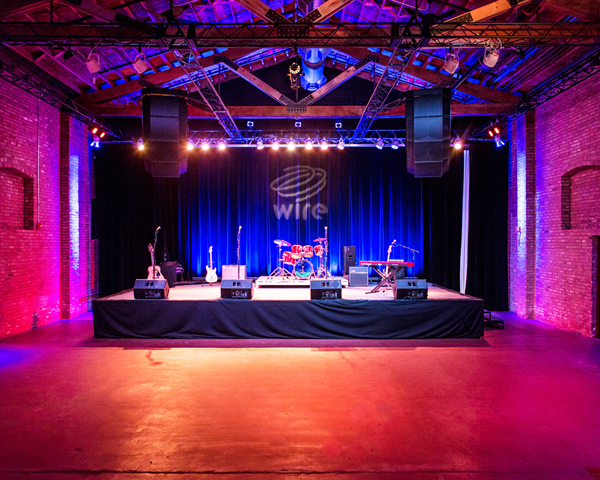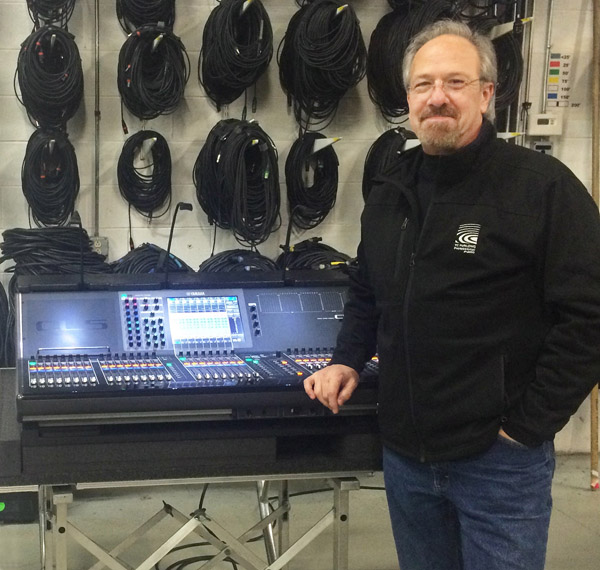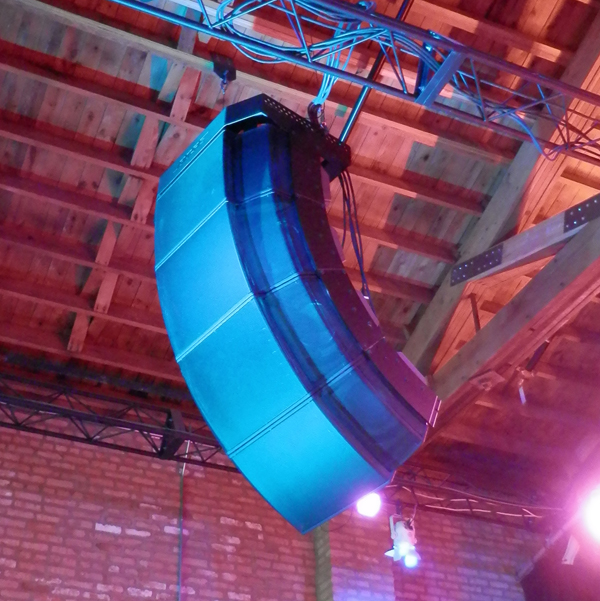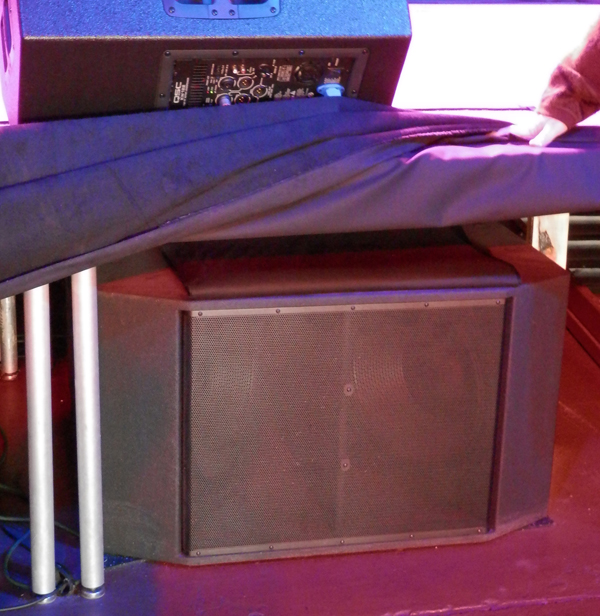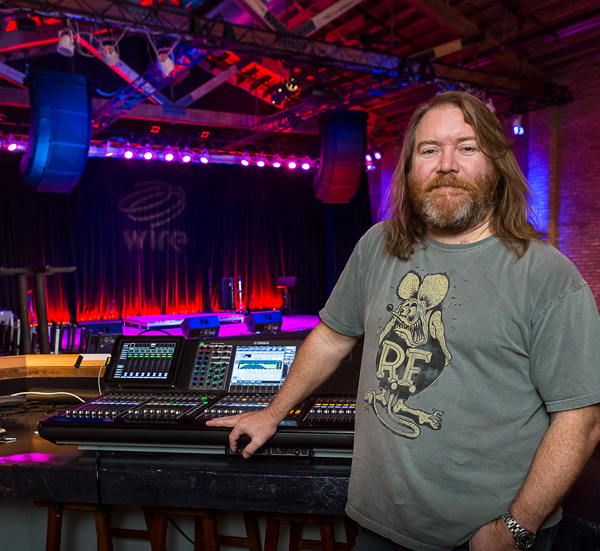Originally published on ProSoundWeb
The poet Henry Wadsworth Longfellow famously said, “Music is the universal language of mankind.” It’s certainly a dialect shared by four lifelong Chicago-area musicians who have come together to create Wire, a venue for live music performance, education and production carved out of an old Teamsters hall in near-west suburban Berwyn, IL.
The four musicians include Chris Neville of Tributosaurus, which faithfully reproduces the recordings of classic rock groups (a different one each month); Paul Bolger of popular jam band Mr. Blotto; Tracy Dear of alt country group Waco Brothers, and Jon Smith, a noted recording engineer.
A collective statement from the partners presents their vision: “Wire was an idea that came about several years ago, an idea that intends to reclaim music’s heritage as a method of communicating – not something done in isolation, but something shared with other musicians, the surrounding community, and the world at large.”
Wire’s stage hosts a steady stream of live performances both diverse and eclectic: rock, blues, reggae, acoustic, jazz – and those that escape easy definitions. Space behind the stage has been carved out as the classrooms for Rock University, where students learn both music and production, and above that is the makings of a soon-to-be implemented recording studio.
The venue is an important part of a thriving transformation of the arts community along Roosevelt Road in Berwyn, just a 20-minute drive from downtown Chicago and already the home of venerable FitzGerald’s Nightclub, a staple of the music circuit celebrating its 35th year.
It’s not surprising given the collective decades of performance experience that the partners are well-informed on the subject of sound reinforcement. Bolger, for example, notes that Mr. Blotto has owned its own PA for two decades, made up of premium components. Equally unsurprising is that they turned to fellow musicians for design and installation of Wire’s house and monitor systems.
Neville’s initial call went to TC Furlong, head of the sound company based in Lake Forest, IL since 1973 that bears his name and also a long-time player on the region’s music circuit. Furlong in turn brought Brian O’Connell of his staff into the loop to serve as project manager, and he too is a veteran player on the Chicago scene, noting, “I’ve known Paul (Bolger) for a long time. Our bands have opened for each other over the years.”
Developing The Space
The building that houses Wire actually began life as the Oak (and later the Oakwyn) Theater in 1934, largely presenting motion pictures. Later it was acquired by the local chapter of the International Brotherhood of Teamsters, which transformed it from a theater into a two-story office building. It remained that way, even after the Teamsters vacated it, until being purchased by the Wire partners.
The interior was essentially “gutted,” revealing a beautiful, open space framed by exposed beige brick. After decades of inattention, the brick was restored to its original beauty, topped by a natural wood ceiling that adds to a warm, clean aesthetic.
A large stage (27 feet wide and 15 feet deep) dominates the front of the room, and looking out from there, one sees a large audience area capable of accommodating about 400, with a bar behind that topped by a VIP area comprised of a couple of the old offices that were left in place.
Right away, it was obvious that the room’s numerous hard, parallel surfaces (the floor is concrete) presented a primary demand of the house loudspeakers: pattern control. At the same time, the partners wanted a system with a highly musical signature.
During the evaluation process, O’Connell tipped off Bolger and Neville to a demonstration being presented by Bose Professional of its RoomMatch loudspeaker arrays at another local theatre. They liked what they heard, and a direction was set.
“RoomMatch has a beautiful musical signature,” Bolger says. “You can hear all of the subtleties, the true tonality of acoustic instruments, the ‘whisper’ of guitar strings. It’s beautiful, clean, and intelligible.”
O’Connell notes that a key aspect of the RoomMatch approach, with models available in numerous dispersion patterns, also met the absolute need for output that could be focused on the audience while keeping stray energy off of the room’s many reflective surfaces. Further, with the TC Furlong team new to RoomMatch, Bose Professional stepped up to provide design support, particularly in terms of modeling via the company’s Modeler software.
Main Configuration
What resulted are flown left and right main full-range arrays flanking the Wire stage, each comprised (bottom to top) of one RM12020 module, two RM9020 modules, and a RM7010 module.
The model numbers reveal the coverage patterns of the modules, with horizontal coverage wider at the bottom (120 by 20 degrees) and then tapering to more narrow (90 by 20 and then 70 by 20 degrees) as you move up the array. The result, according to Bolger, is uniform coverage of the room both front to back and side to side.
“Dispersion is very even, and there’s distinct clarity in fully revealing the subtle detail of the music,” he states. “You can walk anywhere in the room and the hi-hat doesn’t go away, the vocals don’t go away, the real character of the music doesn’t go away.”
The open nature of the space and a truss grid above the stage translated to easy selection of optimum locations to fly the arrays. Meanwhile, there wasn’t enough height to fly the subwoofers with the arrays, so to keep the floor clear of obstructions, the system’s two RMS218 (dual-18-inch) subs are positioned together beneath the center/front of the stage, and they’re in a cardioid configuration topped by a judicious use of digital processing to help keep their output under control.
All main system loudspeakers and the subs are driven by four Bose Professional PowerMatch PM8500N networked amplifiers and managed by a ControlSpace ESP-00 digital processor using four ESP I/O cards. These components are located backstage.
Mix & I/O
The other primary component in the system is a Yamaha Commercial Audio CL5 digital console that’s capable of handling both house and monitors. Fronting the custom sound booth constructed in one of the rear corners of the room, it provides plenty of capabilities for guest engineers.
The console is linked via (Audinate) Dante networking to two Rio stage boxes, one to each side of the stage, that accommodate up to 64 inputs, with another eight inputs available on the console.
“The CL5 is a great choice for this application,” O’Connell notes. “The technology is proven, engineers like to mix on it, there’s plenty of capability, plus we’ll be able to link it via Dante to the recording studio system when it’s ready.”
“This is an excellent console both sonically and operation-wise, with plenty of onboard facilities in terms of effects,” Bolger adds. “Plus it’s great for teaching our students. We like to get them behind the board and show them the cause and effect of what they’re doing on stage as it relates to what’s happening with sound in the house.”
Currently a Dante run from the console feeds a multitrack recorder for capturing live performances, and Cat-5 is also in place to facilitate a Dante link to the main system rack in the near future. (That feed is analog for the time being.)
There really weren’t many options with respect to the booth location – placing it centrally would have impeded crowd traffic flow while also occupying too much prime listening real estate. However, this difficulty is largely alleviated with the use of the console’s StageMix app with an iPad that’s kept at front of house, allowing engineers to dial in the mix from anywhere in the room.
At The Stage
This applies to monitors as well, with the CL5 accommodating up to 16 mixes on stage. Several QSC KW122 (12-inch) active 2-way loudspeakers are available for artists, placed horizontally on their cabinet’s monitor position, with a 15-inch KW152 provided for drum fill. They’re also outfitted with EQ modes for switching between optimized settings with the press of a button on the back panel.
“I really like these boxes as monitors. Both the 12s and 15s get it done,” Bolger says. “I also like that you can adjust them if you want. It’s incredible what compact loudspeakers can do these days.”
“Actually, my band played at Wire a few months ago, and as a musician, I found the stage monitoring situation to be great,” O’Connell adds.
The microphone package offers a variety of models from Shure (SM57 and SM58, several BETA mics, and three KSM137 condensers). Direct needs are met with Radial Engineering ProDi boxes as well as a ProD8 providing eight channels in a single rack-mount box.
All of the equipment hadn’t arrived as the venue’s grand opening date approached, so TC Furlong supplied loaner gear from its extensive rental stock to handle the situation until everything was delivered and installed. The company also provided training on the console and a technician for opening night.
Desired Result
Wire is convenient to expressways and public transportation, seeing notable success in attracting patrons from all over the Chicagoland area for live music several nights a week. It’s already garnered a reputation among musicians as a place to play and be heard, and among patrons who appreciate the care that’s gone into creating the venue.
“It sounds more like a concert hall than a club,” says O’Connell. “This system sounds fantastic, to us and to the club’s owners and to everyone who’s been there.”
“We set out to create a place where we’d want to play as artists, and that’s led to a great result and what we see as a valuable addition to the area music scene,” Bolger concludes. “We’ve worked carefully in how we’ve allocated our resources, and those choices have paid off for everyone involved.”
